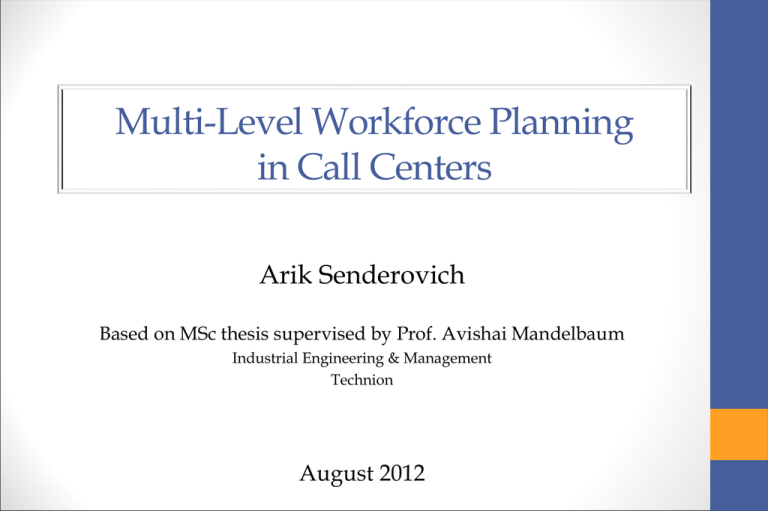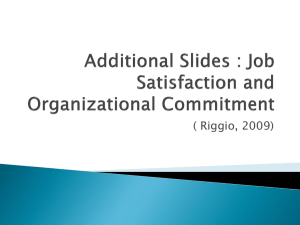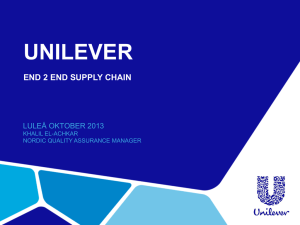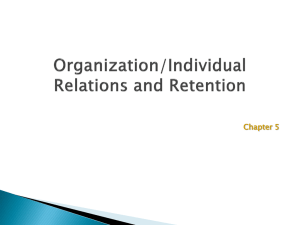Turnover - Faculty of Industrial Engineering and Management
advertisement

Multi-Level Workforce Planning in Call Centers Arik Senderovich Based on MSc thesis supervised by Prof. Avishai Mandelbaum Industrial Engineering & Management Technion August 2012 Outline 1. Introduction to Workforce Planning • Definition and Planning Levels • Our goal – Multi-Level Model for Call Centers • Call Center characteristics for Workforce Planning 2. Multi-Level Workforce Planning in Call Centers • Multi-Level Framework – MDP • Applying two models to test case Call Center • Model Validation • Parameter Estimation • Results and insights 3. Future Research 2 Workforce Planning - Definition A process of aligning workforce capacity with service/production requirements and organizational goals • Strategic Goals: Sales, Customer satisfaction • Operational Goals: Waiting times, Abandonment 3 Literature Review: Robbins (2007) Workforce Planning Levels Top-Level Models: Turnover, Promotions, Recruitment Strategic Planning Months, Quarters, Years Planning Periods Low-Level Models: Training, Absenteeism, Protocols Operational Planning Events, Hours, Days 4 Top-Level Planning • • • • Planning Horizon: Quarters, Years,… Planning periods: Weeks, Months,… Control: Recruitment and/or promotions Parameters: • • • • Turnover rates (assumed uncontrolled) Demand/Workload/Number of Jobs on an aggregate level Promotions are sometimes uncontrolled as well (learning) Costs: Hiring, Wages, Bonuses etc. • Operational regime is often ignored 5 Literature Review: Bartholomew (1991) Low-Level Planning • Planning horizon: Months • Planning periods: Events, Hours, Days,…. • Control: • Daily staffing (shifts, 9:00-17:00,…) • Operational regime (work scheduling absenteeism,…) and routing, managing • Parameters: • Staffing constraints (shift lengths, work regulations,…) • Operational Costs (shifts, extra-hours, outsourcing,…) • Absenteeism (On-job, shift) • Detailed level demand Literature Review: Dantzig (1954); Miller et al. (1974); Pinedo (2010) 6 Workforce Utilization in Call Centers Agent 043, Whole day January 24th , 2010 7 Many customer types, call types, miscellaneous tasks,…. Our goal: Develop and apply a methodology for Multi-Level Workforce Planning in Call Centers 8 Multi-Level Planning • A single dynamic model that accounts for both planning levels: • Low-Level staffing levels do not exceed aggregate constraints • Top-Level employed numbers adjusted to meet demand at low-level time resolution • Dynamic Evolution: Recruit/Promote t t+1 t+2 Meet Demand Literature Review: Abernathy et al., 1973; Bordoloi and Matsuo, 2001; Gans and Zhou, 2002 9 Call Centers – Model Selection • • • • • High varying demand (minutes-hours resolution) Tradeoff between efficiency and service level High operational flexibility - dynamic shifts Low employment flexibility - agents learn several weeks Multiple skills (Skills-Based Routing) Proposed models are tested against real Call Center data 10 Our Framework • Modeling Workforce Planning in Call Centers via Markov Decision Process (MDP) in the spirit of Gans and Zhou, 2002: ? Learning 1 Learning … 2 Turnover Turnover m Turnover • Control: Recruitment into skill 1 • Uncontrolled: Learning and Turnover • States i=1,…,m may correspond to agent-skills , service speeds or length of service 11 Model Formulation – Time, State, Control • T - top-level planning horizon (example: quarters) • t 0,1,...,T - top-level time periods (example: months) • State space - workforce at the beginning of period t: nt (n1,t , n2,t ,...,nm,t ) • xt ( 0) - Control variable at the beginning of period t • Post-hiring state-space vector: ~ ( y , n ,...,n ) n t t 2,t m,t with yt n1,t xt • State-space and control are continuous (large Call Centers) 12 Model Formulation – Learning & Turnover • Turnover at the end of period t: qt (q1,t ( yt ), q2,t (n2,t ),...,qm,t (nm,t )) with ~ k qi,t (k ) q i ,t • q~ - stochastic proportion of agents who turnover i ,t • Learning from skill i to i+1, at the end of period t, is possible only for those who do not turnover: lt (l1,t ( yt ),l2,t (n2,t ),...,lm,t (nm,t )) with ~ li ,t (k ) li ,t (1 q~i ,t )k ~ ~ l • i ,t - stochastic proportion of agents who learn, lm ,t 0 13 Model Formulation - Dynamics • The system evolves from time t to time t+1: ~ n1,t 1 (1 l1,t )(1 q~1,t ) yt ~ ~ ~ n2,t 1 (1 l2,t )(1 q2,t )n2,t l1,t (1 q~1,t ) yt ~ ~ ~ n (1 l )(1 q )n l (1 q~ )n i ,t 1 i ,t i ,t i ,t i 1,t i 1,t i 1,t i 3,...,m Markov property… 14 Model Formulation - Demand • During period t demand is met at low-level subperiods s=1,…,S (consider half-hours) • Given J customer types arriving: • We define Dt as demand matrix (size J S) • Matrix components are Dtj ,s : • Amount of arriving calls at time t, sub-period s of call type j • Example: 10 calls, January 1st , 7:00-7:30, Consulting customer 15 Model Formulation: Costs • Low-Level planning is embedded in Top-Level planning in form of an operational cost function: Ot (n~t , Dt ) • Operational costs considered: shifting expenses, outsourcing and overtime • Ot (n~t , Dt ) is a least-cost solution to the Low-Level problem, given period t employment levels, recruitment and demand • Top-Level costs at time t: • h - Hiring cost of a single agent • Wi - Wages and bonuses for skill-level i agents 16 Model Formulation: Discounted Goal Function • The discounted total cost that we want to minimize is: m T t ~ min E hxt W1 yt Wi ni ,t Ot (nt , Dt ) x0 ,...,xT i 2 t 0 subject to system dynamics • Gans and Zhou: if the operating cost function is jointly convex in n~t there exists an optimal “hire-up-to” policy: * * yt (n2,t ,...,nm,t ) n1,t if yt (n2,t ,...,nm,t ) n1,t * xt otherwise 0 17 “Hire-up-to” policy - Example • January workforce – 100 employees • After turnover – 90 employees • February demand – 110 employees • Myopic “hire-up-to” – 20 recruits • Sometimes NOT enough considering long-run parameters (demand, flow,…) • For example: DP dictates hire 30 • If the number is less than 0 then we hire 0 18 Modeling the Operating Cost Function • We propose the following model for Ot (n~t , Dt ) : • • • w 1,...,W - feasible shifts during time period t xi , w - number of level-i agents staffed to shift w ci , w - cost for staffing level-i agent to shift w m W Ot (n~t , Dt ) min ci , w xi , w xi ,w 0 s.t . i 1 w 1 s x N ( D i,w i t ), i, s w:I(w,s) 1 W x w1 1, w W x w1 i ,w yt ni ,t 19 Applying 2 Models to Test Case Call Center • Models are special cases of Gans and Zhou, 2002 • Validating assumptions and estimating parameters using real Call Center data • Comparing results – Models vs. Reality 20 Test Case Call Center: An Israeli Bank • Inbound Call Center (80% Inbound calls) • Operates six days a week • Weekdays - 7:00-24:00, 5900 calls/day • Fridays – 7:00-14:00, 1800 calls/day • Top-Level planning – quarters • Low-Level planning – weeks • Three skill-levels: • Level 1: General Banking • Level 2: Investments • Level 3: Consulting 21 Model Validation and Application • Training set: Year 2010 SEEData + Agent Career data • Test set: Jan-Mar 2011 SEEData • Top-Level planning horizon: 1st Quarter of 2011 • Top-Level time periods: Months (JanuaryMarch 2011) • Sub-periods (low-level periods): Half-hours 22 Model1: Base Case Model Hiring Entrants Course Agent Dropouts Turnover Model2: Full Model Learning Entrants Learning Hiring Course Level 1 Level 2 Level 3 23 Dropouts Turnover Turnover Turnover Model 1: Assumptions • Single agent skill (no learning/promotion) • Deterministic and stationary turnover rate • Stationary demand • Recruitment lead-time of one period - Reality 24 Model 1 : Formulation xt gt 0 q0 1 q1 gt ~ min h W ( gt nt ) Ot (nt , Dt ) g 0 ,...,gT t 0 (1 q0 ) T Subject to dynamics: yt nt g t gt (1 q0 ) xt 1 0 nt 1 yt (1 q1 ) 25 Validating Assumptions: No Learning 26 No Learning assumption is not valid but Model 1 can still be useful due to simplicity Validating Assumptions: Turnover Monthly turnover rate (2007-2010): 27 Average turnover rate of 2010 serves estimate – 5.27% Validating Assumptions: Stationary Demand • Demand in half-hour resolution: • Not too long - Capturing variability • Not too short – Can be assumed independent of each other Arriving Calls • Comparing two consecutive months in 2010, for total half-hour arriving volume: 28 Half-hour intervals Stationary demand is a reasonable assumption Validating Assumptions: Stationary Demand • We now examine the half-hours for entire year 2010: 29 Model 1: Low-Level Planning W Ot ( yt , Dt ) min cw xw xw 0 s.t. w1 x w w:I(w,s) 1 N ( Dt ), W x w1 1, w s s yt 30 Modeling Demand • General additive model (GAM) was fitted to demand of October-December 2010 (Hastie et al., 2001): • Demand influenced by two effects: Interval effect and Calendar day effect Dt s ,c s c s ,c • Fitting GAM for each customer class j did not influence results 31 Forecasting demand in Call Centers - Aldor-Noiman et al., 2008 Modeling Demand – Weekdays and Fridays 32 Weekdays effect was not significant for total demand Modeling Demand - Weekday Half-Hour Effect 33 Modeling Demand - Calendar Day Effect 34 Modeling Demand – Goodness of Fit RMSE = 39 calls (Approx. 5 agents per half-hour) 35 Not much better than fitting whole (de-trended) year 2010 Agents Online – Learning From Data Learning curve, patience, service times, protocols 36 Staffing Function – Non-linear Spline zs f ( D ) s t 37 On-job Absenteeism • During shifts: agents go on breaks, make outgoing calls (sales, callbacks) and perform miscellaneous tasks • More (half-hour) staffing is required • Israeli bank policy: • Only breaks and some miscellaneous tasks are recognized • Outgoing calls and other back-office work are important, but assumed to be postponed to “slow” hours • Factor of 11% compensation at Top-Level workforce (uniform over all shift-types, daytimes etc.) • We model absenteeism at low-level resolution and show that it is time varying (great influence on planning) • We use Server Networks to answer questions on agent utilization profile 38 Newly hired agent Agent 227, Whole day October 4th, 2010 39 Old timer 40 Agent 513, Whole day October 4th, 2010 Defining and Modeling Absenteeism • Absenteeism rate per interval s as: as T otalabsenteeism per interval ps T otalstaffingper interval z s as • Absenteeism is defined as breaks and other productive work (management decision) • GAM model is fitted (again) to absenteeism rate with covariates: • Time of day • Total arrivals per period • Weekdays-Fridays are separated again • On-shift absenteeism: between 5% and 35% (average of 23% vs. 11% bank assumption) 41 Fitting Absenteeism – Time of Day 42 Fitting Absenteeism – Arrivals 43 Shift Absenteeism • Shift absenteeism: agent scheduled to a certain shift and does not appear (health, AWOL,…) • We model it as probability of not showing up for shift given scheduling • No supporting data, thus assuming 12% overhead corresponding to bank policy • Given data parameters can be estimated and plugged into operational cost function 44 Low-Level Planning: Staffing zs N ( Dt ) z s as (1 ps ) s W Ot ( yt , Dt ) min cw xw xw 0 w1 s ˆ s.t. xw N ( Dt ), s w:I(w,s) 1 W x w1 1, w yt 45 Model 1: Multi-Level Solution • Myopic single-stage “hire-up-to” policy is optimal: • Low-Level planning sets number of employees for each time period t • Gaps are known in advance and filled • Recruitments are made one period ahead • Example: • Low-Level solution January 2011 is 100 employees • In the beginning of December we have 100 employees • We know that 10 will turnover at the end of December • We hire in December 10 to replace them (if no dropouts occur) 46 Model 2 : Assumptions • Model 1 is extended to include 3 skill-levels • Hiring lead-time of 1 period (as before) • No stationary assumptions on turnover, learning and demand are required, but for simplicity we assume all three 47 Estimating Learning and Turnover • We follow the Maximum Likelihood estimate proposed in Bartholomew, 1991 and use the average past transaction proportions: li ni ,i 1 ni • Proportion of learning skill i+1 is estimated with past average proportions of learners: • L1 to L2 - 1.5% • L2 to L3 - 1.1% • Total turnover is estimated as in Model 1: 5.27% L1 L2 L3 Turnover Rate - Stocks 0.0396 0.0084 0.0047 Turnover Rate - Staffing 0.0383 0.0089 0.0055 48 Half-hour staffing Staffing agents online for all three levels: Level 1 Level 2 Level 3 On-job absenteeism is modeled for all three levels Shift-absenteeism – 12% as before 49 Model 2: Solution • Due to model assumptions problem is a LP • Myopic “hire-up-to” policy is not necessarily optimal • Multi-stage “hire-up-to” is promised • Problem: Some skill-levels may be unattainable due to low learning proportions • Solution: Bank recruitment (in reality and in our model) 50 Results Overview 51 Total Workforce 52 Recruitment 53 Models vs. Reality • Uniformly high service levels (5%-15% aban. rate) • Absenteeism is accurately estimated (influences peak-hours with high absenteeism rate) • No overtime assumed – in reality each person is equivalent to more than one full-time employee • In reality budget “tricks” are possible: Engineer for 3 agents • Recruitment in large numbers is usually impossible and therefore smoothed • Having all that said – let us observe reality 54 In reality – growth is gradual 55 Comparing Total Costs Taking learning under consideration can save approx. 153,000 NIS - per quarter 56 Why is Model 2 “less expensive”? • Accurate workforce planning at Level 2 and Level 3 • “Free” recruitment from the bank • But, additional wage is considered for Level 3 employees recruited from bank • If bank recruitment continues all year then it might be more expensive in the long run (we planned for 1 quarter) • Bank employees – not infinite pool 57 Rolling horizon updates • Planning Horizons are to be selected: • Long enough to accommodate Top-Level constraints (recruitment lead-times, turnover,…) • Short enough for stationary assumptions to hold and statistical models to be up to date • Improve estimates through newly updated data • Workforce Planning (cyclical) Algorithm: 1. Plan a single quarter (or any planning horizon where assumptions hold) using data 2. Towards the end of planning period update models using new data (demand modeling, staffing function, turnover, learning, absenteeism…) 58 Future Research • Solve the full model with the addition of controlled promotion rates • Prove “hire-up-to” optimality for: • Recruitment to all levels (non-linear operating function, stochastic time-varying turnover and learning) • Controlled promotions instead of learning • Validate our models for bank’s new data (daily updated) • Simulation-based optimization for Low-Level planning (Feldman, 2010) • Server Networks and their applications 59 Thank you… Questions/Remarks? 60







